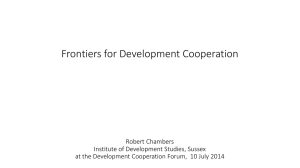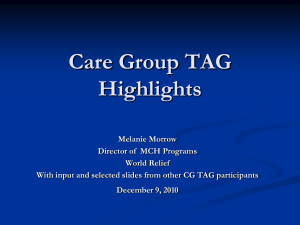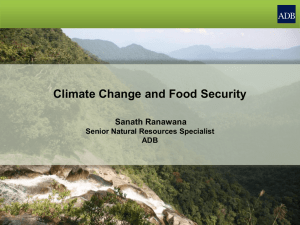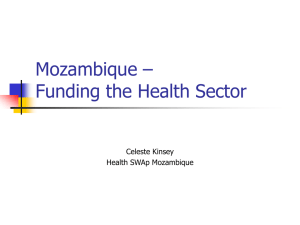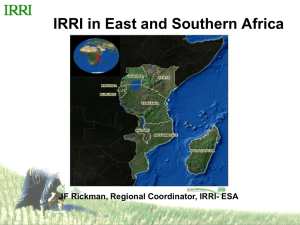Mozambique
advertisement
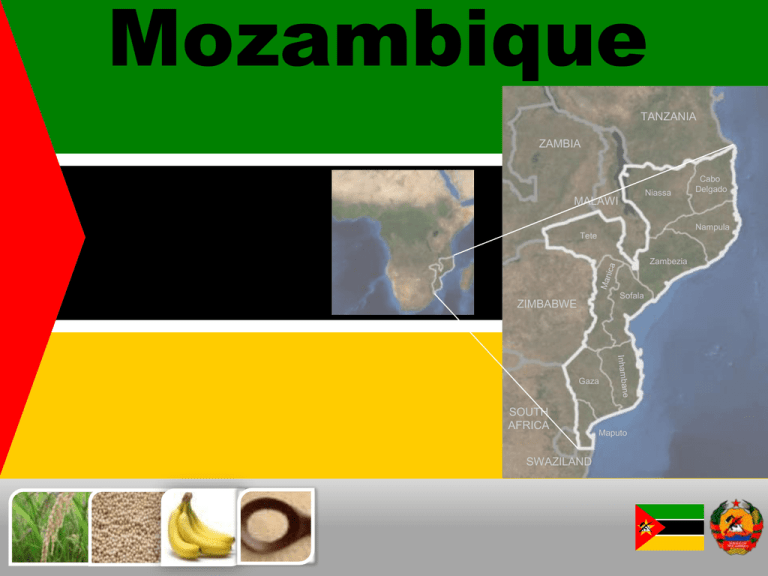
Mozambique TANZANIA ZAMBIA Niassa MALAWI Cabo Delgado Nampula Tete Zambezia Sofala ZIMBABWE Gaza SOUTH AFRICA SWAZILAND Maputo Agenda Why Invest in Agriculture in Mozambique Agribusiness Strategy and Corridor Attractiveness Agribusiness Opportunities in Mozambique 2 Mozambique at a Glance Mozambique is a stable, high economic growth country with substantial agricultural potential Demographics (2011) Niassa Cabo Delgado Nampula Population: 23.9 million Population Growth (5 Year CAGR): 2.4% Capital: Maputo National Language: Portuguese Business Languages: Portuguese & English Tete Land and Climate Zambezia Manica Sofala Area: 800,000 km2 (~80 million ha) Arable Land: 36 million hectares Climate: Tropical to Sub-Tropical Key Economic Indicators (2011) Inhambane Gaza Maputo Source: IMF World Economic Outlook Database, September 2011; World Bank 3 Currency: Metical, Abbreviation: MZN GDP: USD 12.8B GDP per Capita: USD 535 Projected Annual GDP Growth: almost 8% per year average until 2015 Agriculture Contribution to GDP: 32% Mozambique: A Nation of Potential The country’s potential can be captured in four key areas 36 million ha of arable land, mostly unutilized Tropical to sub-tropical climate with fertile soil and ample rainfall Tremendous irrigation potential from major rivers Significant private sector investments Major infrastructure investments Numerous innovative publicprivate partnerships Excellent AgroEcological Conditions Enabling Environment for Investments Strong Market Dynamics Government Commitment to MarketDriven Growth Strong and growing economy Reliance on imports: Large import substitution opportunity Coastal position: Access to international and regional markets Agricultural development seen as critical to country’s development, with activities across sectors focused on 6 agriculturally attractive corridors Government business incentive programs Specific organizations set up to organize and assist investors 4 Excellent Conditions for Agriculture Mozambique boasts ideal growing conditions – plentiful water supply combined with diverse micro-climates support a broad range of agricultural commodities Utilization of Arable Land 36.0 5.4 30.6 85.0% Arable Land Land Suitability EXTENSIVE WATERWAYS Hectares 15.0% Major rivers such as Zambezi, Limpopo, Save, and other tertiary rivers offer tremendous irrigation potential Utilized Unutilized VAST UNUTILIZED ARABLE LAND High Agricultural Potential 10 DISTINCT AGRO-CLIMATIC ZONES YEAR-ROUND PRODUCTION POTENTIAL Tropical climates offer potential for year-round, high yield crop production Source: Ministry of Agriculture; World Bank 5 Suitable for rainfall agriculture Moderately suitable for rainfall agriculture Diverse Agro-Ecological Zones There are 10 distinct agro-ecological zones in Mozambique offering potential for a wide variety of crops to be grown Main Agro-Ecological Regions in Mozambique R9 R8 R7 R10 R10 R1 R2 R3 R7 R10 R7 R7 Region R4 R8 R6 R7 R6 R4 R6 R8 R5 R5 R5 R6 R10 R7 R3 R2 R1 R8 R9 R10 Part of Mozambique Inland Maputo and south Gaza Coastal region south of the Sabi (Save) River Center and north of Gaza, and west Inhambane Medium altitudes of central Maputo Low altitudes of Sofala and Zambezia Semi-arid region of Zambezi Valley and Southern Tete Medium altitudes of Zambezia, Nampula, Tete, Niassa, and Cabo Delgado Coastal litoral of Zambezia, Niassa, and Manica North interior of Cabo Delgado High altitudes of Zambezia, Niassa, and Manica Source: Ministry of Agriculture; World Bank, IFAD 6 Ag. Commodities Produced Maize, cowpea, groundnut, cassava, sweet potato, banana Maize, sugar, cowpea, sweet potato, groundnut, cassava Cattle, goats, rice Maize, sorghum, cassava, cowpea Rice, cotton, cashew Sorghum, millet, sugar, rice Maize, soybean, sorghum, cassava, cowpeas, groundnuts, rice, sesame Banana, cassava, millet, rice, cashew Maize, sorghum, cowpeas, cassava, sesame Soybean, maize, common beans, potatoes, rice Strong and Growing Economy The Mozambican economy has displayed strong growth and is expected to continue growing at one of the fastest rates in the world GDP Trend (2000 to 2015 est.)1 Industry World's Fastest Growing Economies (2011 to 2015 est.) Services Year over Year Growth +8% Estimated CAGR Agriculture 17.4 USD B CAGR +8% 4.2 51% 2000 25% 24% 6.6 25% 27% 48% 2005 9.6 23% 32% 45% 2010 9.5% 8.2% China 2015 est. India 8.1% Ethiopia Mozambique Note: 1) Growth rates are based on nominal prices Source: IMF World Economic Outlook Database, September 2011; World Bank; The Economist Intelligence Unit; National Institute of Statistics 7 7.7% Location with Optimal Market Access Mozambique has an advantageous geographic positioning, providing an ideal gateway to both international and regional markets Mozambique: Proximity to High Opportunity Markets Mediterranean China/ India Middle East Neighboring Countries 8 Natural gateway to the Middle East, Mediterranean, and Asia Bordering regional markets like South Africa, Zimbabwe, and Malawi Port upgrades at Nacala and Beira will further trade opportunities Trade Potential as a SADC1 Member As a member of the Southern African Development Community, Mozambique has access to an agricultural market worth over USD 3B Southern African Development Community Members Democratic Republic of the Congo Tanzania Seychelles Angola Zambia Malawi Zimbabwe Namibia Botswana Mozambique SADC Trade Agreements The SADC trade agreements aim to: Eliminate barriers to intra-SADC trade Eliminate import duties based on a phased approach Eliminate all export duties Eliminate non-tariff barriers Apply no new quantitative import restrictions Eliminate quantitative export restrictions Mauritius Trade Opportunity Within SADC Madagascar Swaziland South Africa Lesotho Balance of Trade Value for Agricultural Products in SADC Region1 3.4 Under SADC trade agreements, Mozambique aims to have access to barrier-free trade with other member states USD B 3.2 2.1 1.3 2008 2009 2010 2011 Note: 1) Southern African Development Community; 2) Trade balance calculated as total value of imports less total value of exports Source: SADC; International Trade Center 9 Government Support Agricultural transformation is a priority within the highest levels of government and investors are offered attractive incentives and support FOCUS ON AGRICULTURE President Guebuza is a cofounder and champion of Grow Africa1 Agricultural growth is a high priority for the government to: INVESTMENT INCENTIVES – Enhance employment and income potential – Enhance food security 10-Year Strategic Plan (PEDSA) for agricultural sector development in place – Focused on six growth corridors Exemptions on equipment importation duties Real property transfer tax reductions Reduction in corporate income taxes: – Agriculture corporate income tax generally 10% – Effective tax rate can be 2% until 2015 and 5% until 2025 Low cost land – 50 year lease with 49 year potential extension of land for ~USD 1/ year/ hectare INSTITUTIONAL SUPPORT Agencies dedicated to facilitating investment – The Investment Promotion Agency (CPI) and Centre for Promotion of Agriculture (CEPAGRI) promote and support agricultural investment opportunities – GAZEDA dedicated to the Nacala Economic Zone Some corridors also have organizations focused on developing and coordinating investments Note: 1) Grow Africa is a series of conferences and interactions that connect the private sector and governments, focusing on accelerating investments Source: Investment Promotion Agency Website 10 Growing Foreign Direct Investment Mozambique has recently attracted many large private sector investments, ranging from the mining and natural gas sectors to agriculture FDI Inflows (2007 to 2011) USD M 2,100 893 592 427 789 2007 2008 2009 2010 2011 Foreign direct investment (FDI) in Mozambique grew nearly fivefold from 2007 to 2011 Aggregate FDI from 2007 to 2011 amounts to USD 4.8B FDI is largely led by the expanding mining and natural gas sectors FDI by Sector (2011) Sample of Large, Recent Projects Priority is being given to agriculture when attracting foreign investors in the hope of improving productivity, reducing dependency on imports, and helping cut food prices Transport and Agriculture Communication 3% 2% Other Sectors Financial 2% Activities 6% Vale: USD 6B coal mine Anadarko: Estimated USD 30B+ by 2017 Mozal JV: USD 2.5B aluminum project Green Resources: USD 2.2B eucalyptus plantation and industrial infrastructure Matanuska: USD 60M invested to date focused on bananas Olam: USD 50M+ investment in rice Extractive Industries 87% Source: World Bank; Investment Promotion Agency; IMF 11 Ongoing and Planned Infrastructure Projects Project 1 1 1 2 TRANSPORT INFRASTRUCTURE 3 4 5 6 7 8 9 Deepening of Beira Port Beira Coal Terminal Beira Coal Terminal Nacala Airport Rehabilitation of Beira railway (570km, 5–8MT/Y) Nacala Corridor (24MT/Y) Tete Bridge Nacala Port (20–25MT/Y) Public Transport Network Catembe Bridge and Ponto do Ouro Roads Maputo Public Transport THERMOELECTRIC POWER Project Gigawatt — RG Moazite — 11 Phase 1 12 Benga 10 HYDROELECTRIC POWER Date of Completion 2012 2012 2012 2012 120 2013 2,600 190 295 (phase 1) 980 2014 2014 2015 Unknown 750 Unknown 310 Unknown Capacity (MW) Investment (USD M) Type Date of Completion 100 230 Natural gas 2013 300 1,500 Coal Unknown 600 1,300 Coal Unknown Project 13 14 15 16 17 Investment (USD M) 300 140 400 111 Lupata Boroma Cahora Bassa North Mphanda Nkuwa Moamba Major Capacity (MW) Investment (USD M) Date of Completion 520 165 1,200 1,500 17 800 250 1,100 2,600 500 2016 2016 2017 2017 2020 12 2 15 16 4 5 12 14 11 3 13 1 Infrastructure – including road, rail, ports, airports, and electricity generation – is under development; providing better capacity for linking agricultural products to markets 17 8 7 10 9 Source: Banco Nacional de Investimento , Ministry of Energy, Ministry of Public Works 6 Innovative Agricultural Partnerships Innovative public-private partnerships to transform Mozambique’s agriculture are being implemented Examples of Successful Public-Private Partnerships Underway Beira Agr. Growth Corridor (BAGC) Partnership – Catalytic Fund of USD 20M in publicly-backed investment for startup agribusinesses – First African country with a dedicated catalytic fund for agriculture AGRA + Standard Bank – USD 25M loan guarantee facility GoM + World Bank – USD 70M irrigation program (“Proirri”) USAID Agrifuturo – Program to promote agribusiness Pro Savana – Partnership between GOM, Japan and Brazil to develop agribusiness 13 Agenda Why Invest in Agriculture in Mozambique Agribusiness Strategy and Corridor Attractiveness Agribusiness Opportunities in Mozambique 14 Aligning Efforts Across Stakeholders The four stakeholder groups of the Public and Private sectors along with People and development Partners are key to developing Mozambique’s agriculture potential • Enabling environment • Infrastructure • Research • Expertise • Markets • Commercial Financing Public Private Sector • Community support & engagement • Human capital and capacity Sector Mozambican Development People Partners 15 • Patient capital • Skills and training Importance of Agriculture in Mozambique’s Strategy Agriculture is a key priority for the Mozambican government for poverty reduction and attaining food security, as is detailed in the country’s ten-year strategy plan Summary of the Strategic Plan for Agricultural Development (PEDSA), 2011 to 2020 Vision: An integrated, prosperous, competitive and sustainable agriculture sector 6 corridors targeted to align efforts across public, private, and development sectors through: – Agricultural potential – Support services (research centers, educational institutions) – Connection to market (infrastructure) 1 2 Agricultural production and productivity to increase ability to compete 3 Infrastructure and services for markets and improved marketing 4 Land, water, forest, and wildlife resources used sustainably Agricultural institutions strengthened Four Discrete Pillars in Progress to Achieve Agricultural Vision Mozambique plans to allocate 10 percent of its budget to agriculture by 2015, as resolved in the Maputo Declaration of 2003 by the African Union Source: Ministry of Agriculture 16 Agriculture Growth Corridors Of Mozambique’s six agricultural corridors, Nacala, Zambezi Valley, and Beira corridors are being highlighted due to their high agricultural potential Of the six corridors identified in Mozambique’s strategy… …this action plan will focus on the following three corridors Six Corridors in Agricultural Strategy Provinces within Beira, Nacala, and Zambezi Valley Corridors1 Cabo Niassa Delgado Nacala Zambezi Valley Nampula Tete Beira Pemba Lichinga Limpopo Maputo Why These Three Corridors Have Significant Potential Zambezia Manica Sofala Inhambane Gaza Maputo Agricultural opportunity due to soil and climate, while most of country’s water is here Level of existing or planned infrastructure, including ports Existing framework to attract / manage investments2 Alignment with other efforts3 Economic zones4 Note: 1) Color coding represents approximate positioning of corridors; 2) Zambezi Valley Development Authority and Beira Agricultural Growth Corridor; 3) ProSAVANA in Nacala Corridor; 4) Nacala Economic Zone exists now with Beira Economic Zone planned Source: PEDSA, Government and Expert Interviews 17 Nacala Agricultural Growth Corridor The government has focused significant resources and business-friendly investment programs on the Nacala Corridor Attractiveness of Nacala Nacala Special Economic Zone Nacala Port Potential Nacala Special Economic Zone provides 500 ha industrial free zone with no VAT and customs duties, as well as technical assistance Upgrade of the deepest port on East African coast at Nacala The mining sector is increasing demand for agricultural products; currently imported from South Africa at high cost Bananas The Pro Savannah project is mapping land potential Mining Rei do Agro: Mozambican company investing USD 5M for soy and maize production Green Resources: USD 2.2B eucalyptus plantation and industrial infrastructure Matanuska: USD 60M invested to date focused on bananas USD 4.4B upgrade to rail by Vale Soybeans Demand from Mining Land Mapping Investments Made Forestry Source: Ministry of Agriculture 18 Zambezi Valley Corridor Zambezi Valley has the greatest agricultural potential, with the highest concentration of the country’s water resources Attractiveness of Zambezi Valley Vast Water Reserves Broad Crop Variety Investments Made 80% of the country’s water reserves are found in the Zambezi Valley corridor Large Local Demand Chinese government USD 50M investment for cotton, maize, and rice processing facilities USD 70M World Bank PROIRRI irrigation project, mainly aimed at irrigation for rice Olam is investing USD 50M over the next 4 years Estimated USD 1B port investments by Rio Tinto AgroProcessing Diverse topography and good rainfall during cropping season provides perfect climate for a variety of crops Irrigation1 Rice Local market potential as one of the most densely populated provinces Port Infrastructure Note:1) PROIRRI project is part of both the Beira and Nacala Corridors Source: Zambezi Valley Development Agency 19 Beira Agricultural Growth Corridor Beira currently has the most developed infrastructure and linkages to neighboring countries Attractiveness of Beira Infrastructure and Connectivity to Region Demand from Mining Activities Investments Made Well-developed infrastructure with road and rail network linking Zambia, Malawi, Zimbabwe and Mozambique to the port of Beira USD 20M for the BAGC Catalytic Fund First catalytic fund dedicated to agriculture in Africa, which is already leading to a number of investments Catalytic Fund A number of multi-billion dollar mining investments are going ahead, which will improve access to infrastructure in the region and boost local demand USD 70M World Bank PROIRRI irrigation project, mainly aimed at irrigation for rice USD 67M from JICA and EU for upgrades to the Port of Beira Irrigation1 Beira Port Note: 1) PROIRRI project is part of both the Beira and Nacala Corridors Source: BAGC 20 Additional Growth Corridors The other corridors – Pemba-Lichinga, Limpopo, and Maputo – also present potential and additional value chains Pemba-Lichinga Attractiveness Higher altitudes inland are very well suited to crops such as soybeans Significant investment underway to complete a road connecting Lichinga to Malema by 2014 Large tracts of available land provide easier expansion opportunities Limpopo Attractiveness Well established irrigation infrastructure in Chókwè can facilitate production Features technological support from the South Investigation Center based in Chókwè Quality road infrastructure connects to Maputo Maputo Attractiveness Proximity to Mozambique’s largest city and South Africa provide strong market potential Most extensive infrastructure in both roads and port availability further facilitate market access Crop Potential Crop Potential Crop Potential Soybeans, maize, potatoes, wheat, beans, cotton, tobacco, poultry, and aquaculture Rice, sugar, vegetables, livestock, and poultry Rice, vegetables, fruits, livestock, and poultry Source: Ministry of Agriculture, Expert interviews 21 Agenda Why Invest in Agriculture in Mozambique Agribusiness Strategy and Corridor Attractiveness Agribusiness Opportunities in Mozambique 22 Commodities Analyzed For the sixteen prioritized commodities, additional information is included in differing levels of detail to supplement the investment cases distributed during the Forum I Detailed Investment Opportunities Rice Soybeans Banana Sesame Sugar Cane Poultry Tea Cashew II Rationale for Investment Described Cassava Maize Vegetables Cotton Forestry Aquaculture Livestock Fruit Groundnuts III Highlights of Opportunities 23 Pulses Commodities Analyzed For the sixteen prioritized commodities, additional information is included in differing levels of detail to supplement the investment cases distributed during the Forum I Detailed Investment Opportunities Rice Soybeans Banana Sesame Sugar Cane Poultry Tea Cashew II Rationale for Investment Described Cassava Maize Vegetables Cotton Forestry Aquaculture Livestock Fruit Groundnuts III Highlights of Opportunities 24 Pulses Rice Executive Summary Market Investment Opportunities Major gap exists between domestic production and demand Climate and soil are very well-suited to rice, with opportunities for year-round production Significant investment is underway, which may dramatically improve current infrastructure and raise rice yields There are business opportunities in several parts of the value chain as well as for an integrated producer One of those opportunities is a medium-size milling facility, which requires investment of ~USD 5M Would be supported by 3,000-5,000 smallholder farmers 25 Rice – Market Analysis (1/2) Market Rice consumption has doubled over the past decade, but without significant reductions in rice importations Growth Potential Production growth has not been able to overcome demand growth – keeping imports high Mozambique has the 3rd highest rice consumption in SADC, but is mostly dependent on imported rice – Unlike neighbor countries, the share of imports has not reduced over time and instead remains around ~60% – Despite the significant growth potential for rice (Mozambique’s climate and soil are considered very well-suited to rice), domestic production has only grown at the same rate as imports Without increased local production, this gap will only grow due to a projected 7% domestic demand increase per year Consumption of Rice (in ‘000 tonnes) +90% 455 239 2000 80% 2009 Share of Imported Rice on Local Consumption 62% 60% 40% 9% 20% 0% Gap: Neighbor countries reduced imports to ~10% 2004 2005 2006 2007 2008 2009 2010 2011 Mozambique Source: IRRI, FAOSTATS, USDA 26 Zambia Malawi Rice – Market Analysis (2/2) Market Significant investment is underway by the government, private sector, and development partners to grow rice production Large, Recent Investments 1 2 OLAM: Rice production and processing facility in Zambezia, expanded over the next 5 years Partnership with local producers, also used for cotton Ubunto: Rice production and processing facility in Matutuine Partnership with the Libyan Investment Fund Processes 600 ton/ day and sells ~27,000 ton/ year Key Geographies USD 50 M Niassa ~USD 33 M Cabo Delgado Nampula Tete 4 3 World Bank1: NON-EXHAUSTIVE Investment Expected 1 Zambezia Manica Investments plan to improve agriculture infrastructure of over the next five years, specifically with irrigation development Sofala ~USD 70 M % National Production Inhambane Gaza 4 International Rice Research Institute2: Present in Mozambique since 2006, focusing on rice breeding, socio economic studies, crop production, productivity and private sector-village programs N/A Maputo 4 2 > 30% >20% 4 Note: 1) Areas non identified; 2) IRRI has three research and development regions in Mozambique: Maputo and Xai-Xai for irrigated conditions and Quelimane for rain fed condition. Source: Interviews, Africa Agriculture News, World Bank, OLAM, IRRI, Monitor Analysis 27 >10% >1% ~0% Rice – Investment Opportunities (1/3) Investment Opportunity Several entry opportunities exist throughout the rice value chain Value Chain Analysis Infrastructure Inputs Only 3% of small and medium-size rice farmers use improved seeds Seed Importer Research Center No specific names Current Situation Potential Opportunities Players Production Milling Lower yields as farmers frequently are not leveraging optimal farming technique, including irrigation practices Leasing of machines Irrigated farms Typically integrated if larger player ~15% grains lost after harvest because of old machinery1 Capacity incompatible with expected raise of production Independent mills Integrated mills OLAM Inácio de Souza Moçfer Note: 1) Inputs offered by the mill includes irrigation, selected seeds, fertilizers and chemicals; they are offered as a way to obtain a more homogeneous and high quality supply of paddies; 2) In South Africa, this percentage is ~9%. Source: Interviews, Agrifood (2005), Monitor Analysis 28 Rice – Investment Opportunities (2/3) Investment Opportunity In the proposed investment, the mill assumes a central role in the rice value chain, including supporting famers to improve quality and yields Rice Mill Facility “Invest ~USD 5 M in a Rice Mill to process rice in partnership with smallholders farmers” Infrastructure Inputs Production Selected Seeds High-Quality Paddy Smallholder Farm Seed Seller Milling Training1 Mills Rice Market Money Legend: (Color of Pictures) Own Company Partner/ Consumers 1 Sourcing Model: 100% small/ medium size farmers (training, seeds, credit) Note: 1) Potential irrigation to assist farmers not modeled Source: Interviews, Agrifood (2005), Monitor Analysis 29 2 3 Processing: more than 30,000 tonnes/ year Targets: Domestic consumers Rice – Investment Opportunities (3/3) Investment Opportunity Investing in a rice mill in Mozambique is an attractive opportunity for investment, with significant margins and meaningful social impacts PRELIMINARY Rice Mill Facility Expected Margins by Share of High-Quality Grain (in %, 2012) Key-Financial Indicators Farmers’ Yields: may vary from 2 ton/ ha (rain fed farm) to 4 ton/ ha (irrigated farm) Whole Grain (%) Broken Grain (%) Number of smallholders supported: between 3,000 and 5,000 farms1 Price per kg: USD 1/ kg (whole grain), USD 0.75/ kg (broken) and USD 0.3/ kg (bran) 20% Expected margin: typically vary from 20% to 22%, but with potential to raise up to 25% 20% Investment estimated: acquisition of small mill may require investment of ~USD 5M2 45% Improved farming techniques can help achieve greater rice quality, helping push margins towards 25% Margin (Post-tax) Return expected: similar investments has reported IRR between 13% and 15% Average Practices 25% 25% 30% 35% 40% 35% 30% + Irrigation, Training, Seeds Note: 1) Dependent of the extend of irrigation used; 2) Potential irrigation to assist farmers not modeled Source: Interviews, Monitor Analysis 30 24% 22% Improved Practices Soybeans Executive Summary Market Investment Opportunities Demand for soybeans is increasing due to the development of poultry and soy oil sectors Downstream markets are highly dependent on imported inputs High availability of natural resources may benefit expansion of soybeans crop There are business opportunities throughout much of the value chain, as well as for an integrated producer A ~USD 4.5 M soy extraction & refining center was selected as an example, utilizing 3,500-4,000 hectares of soybean fields as inputs ~1,400 smallholder farmers included into the supply chain 31 Soybeans – Market Analysis (1/2) Market Soy cake is a considerable cost for the poultry industry and could be a key driver of domestic production substitution of imported chicken Soy Cake: Strategic Segment Poultry industry: Though soy is a small share of feed by volume, it represent almost half of costs Poultry’s consumption is growing throughout Southern Africa and is projected to continue expanding in Mozambique at 13% per year over the next decade Composition of Poultry Feed, Volume (2005) 100% 60% 1 kg Poultry Feed = Government is actively encouraging growth of domestic soybean industry to substitute imported soy cake, which is a critical and expensive feed component for poultry Feed Importation of high-priced soy cake is driving up prices for domestic poultry, making competition with imported chicken difficult Maize 40% 20% NonMaize Others 20% Soy Cake Costs for Chicken Producers in Mozambique (2005) Others Costs – Leading component of domestic poultry cost is feed (~74%) – Local production of soy cake should reduce costs, improving competitiveness of the poultry industry 37% of total costs (50% of feed costs) corresponds to soy cake expenses 26% 74% Feed Source: TechnoServe 32 Soybeans – Market Analysis (2/2) Market Opportunity to refine “waste” byproduct oil from processing soy cake in North will continue to grow with expansion of soy industry Soy Oil: Potential to Grow Geography: Historically, crude soy oil is imported and then processed in refineries for further sale Domestic soy oil market is nascent and lacks constant input supply, relying almost entirely on imports Soy Oil Market in Mozambique (2011) However, interest is increasing as soy oil can attract a higher price point (18%) than vegetable oil blends, mainly made from palm oil (an inferior substitute) Cabo Delgado Niassa Nampula North: feed manufactures frequently waste soy oil by-product after processing soy cake Tete Zambezia When soy cake is separated for soy oil domestically, much of byproduct oil is not utilized, providing a market opportunity Manica Sofala North & Center: North & Center: limited limited soy oil soy oil processing, but processing, but growing interest growing interest Inhambane This opportunity will only continue to expand as poultry demand, and consequently soy cake production, increases Gaza Maputo Source: TechnoServe 33 South: more mature and largest soy oil market, refineries import crude oil and refine oil for sale Soybeans – Investment Opportunities (1/3) Investment Opportunity There are opportunities in numerous parts of the value chain, as well as for an integrated producer Value Chain Analysis Segment Infrastructure Inputs Production Processing & Refining Demand Current Situation Opportunity Players Seed Importer Rei do Agro Fertilizer Factory Pannar Farm N/A Soybean Processing: Additional capacity required for expected growth in demand Oil Refining: Current waste of oil byproduct by soy cake manufacturers Processing & Refining Facility Mafuia Oil Sanoil JAM Poultry: Opportunity to compete with imports to meet growing need of livestock farmers Feed Manufacturing Novos Horizontes Abilios Atunes Silos N/A Warehouses Soybean Input Supplier: Lack of availability of seed and inoculants Soybean Farming: Insufficient soybean production exists within country to meet demand Soybean Storage: Insufficient warehouses and silos for storage of locally produced grains Source: Interviews, TechnoServe Analysis, Monitor Analysis 34 Soybeans – Investment Opportunities (2/3) Investment Opportunity PRELIMINARY Soy Extraction & Refining Center Invest ~USD 4.5 M in a Soy Extraction & Refining Center, with inputs and training to get new smallholder farmers into the supply chain to enhance supply Infrastructure Inputs 1 Sourcing Model: 20% from own farm and 80% from smallholders (assistance for training, seed selection, credit) Production Process & Refining Crude Soy Oil Refined Soy Oil Smallholder Farm Soybeans Processing Medium-Size Farm (Color of Pictures) Own Company Partner/ Consumers Market 4 Soy Legend: Oil Refining Demand 2 Cake Processing Facility: Capacity to process more than 9 M ton/ year of soybeans Source: Interviews, TechnoServe, Monitor Analysis 35 Targets: Domestic consumers Feed Feed Development 3 Products: Refined Soy Oil & Soy Cake Livestock Soybeans – Investment Opportunities (3/3) Investment Opportunity Invest in a soy extraction & refining center in Mozambique to achieve attractive margins and returns, with strong social impact PRELIMINARY Soy Extraction & Refining Center Revenue & EBITDA Margin Expected (in ‘000 USD and %, 2014-2018) Key-Financial Indicators Famers’ Yields: between 1.0 ton/ ha (rain fed farm) and 3.0 ton/ ha (irrigated farm) Crop Sales Price: USD 0.39/ kg Number of smallholders: increase from 500 up to 1,600, with average land of 2 ha/ farm Revenue EBITDA Margin 10% 22% 29% 4,607 27% 4,983 3,646 Cost per hectare: between USD 320/ ha and USD 1,100/ ha1 1,779 Investment estimated: total CapEx of ~USD 4.5 M2, ~90% invested on the first two years 76 -524% Return expected: similar investments has reported IRR up to 19% Year 1 Year 2 Year 3 Note: 1) Dependent of the number of smallholders added by year; 2) Potential irrigation to assist farmers not modeled Source: Interviews, TechnoServe, Monitor Analysis 36 Year 4 Year 5 Banana Executive Summary Market Investment Opportunities Opportunity to meaningfully increase Mozambique’s banana exports – Demand imbalances exist in the Middle East, the Mediterranean, and to a lesser extent Southern Africa – Year-round, high-yield crop potential within Mozambique provides additional export opportunities and improved margins Potential for lower farm costs than other competitors Value chain integration is the basis for an attractive investment prospect Opportunity for an investment of $5–6M in a 300 hectares commercial banana plantation leveraging nearby producers to achieve scale at lower investment levels 37 Banana – Market Analysis (1/2) Market Mozambique’s banana industry is well situated to benefit from both its geographical position as well as potential cost advantage Banana Trade Balance (in ‘000 tonnes, 2001 – 2009) Mozambique Competitive Advantage Ability to feed large demand imbalances in the Middle East, the Mediterranean, and to a lesser extent Southern Africa – Demand imbalances have increased at different paces in these regions over the last years, with greatest growth in Europe – Europe: Has competitive export tariff advantage for African countries over most of Latin America, (value of USD 3 per box) – Middle East: Mozambique has 8 to 10 vs. 20 days shipping transit time to Middle East when compared to Latin America and Philippines days1 – Mozambique’s lower farm to port costs than Philippines, coupled with Philippines production being diverted to China, has heightened opportunity in the Middle East Note: 1) Assuming direct shipping Source: FAOSTAT; Interviews with experts; TechnoServe, Abt, Monitor Analysis 38 CAGR +6% 2001 1,600 2009 +3% 994 443 550 +15% 8 Mediterranean Middle East 25 Southern Asia Farm to Port Costs (in USD) +8% $7.50 $8.10 Mozambique Philippines Banana – Market Analysis (2/2) Market While companies in the South focus on internal markets and neighbor countries, companies in North focus on overseas markets NON EXHAUSTIVE Banana Market in Mozambique Main Companies 1 Cabo Delgado Niassa Nampula Tete North: exporting bananas to mainly Middle East from Nacala port – At full production, Matanuska plans to ship 100 containers per week 1 Zambezia Manica 2 Bananalândia: exports 40,000 tonnes (80% of total production) mainly for South Africa, Swaziland and Botswana 3 Conglomerate of 5 companies1: exported 35,000 tonnes per year and created 2,500 direct jobs Sofala Inhambane Gaza 2 3 Matanuska: invested $60M to date to develop a 3,000 ha plantation in Nampula province South: responsible to supply Maputo metropolitan area and neighbor countries Maputo Note: 1) Libombos Macadamia, Frutas Libombos, AAA Enterprises, Tropical Fruit and Rio Verde Source: CEPAGRI; Interviews with experts; TechnoServe, Abt, Monitor Analysis 39 Banana – Investment Opportunities (1/2) Investment Opportunity Value chain integration is the basis for an attractive investment prospect, with involvement from farm production through delivery Farming Post-Harvest Handling 36%1 3%1 Transportation and Marketing Value Chain (% of total value added) 13% Cleaning & Packaging 19% Ripening 30% Transport 38% Agent Fees Transport & Marketing 61%1 Transport cost is one of the main drivers of costs – It constitutes almost 20% of the total farm-tomarket value chain, thus being a key competitiveness driver for exports Another important part of the value chain is the cleaning, packaging and ripening of bananas – Usually small producers do not capture much of the potential value of their investments because they lack these facilities Note: 1) Percent of value added in the value chain Source: GDS; Monitor Analysis 40 Banana – Investment Opportunities (2/2) Investment Opportunity A mid-size commercial banana plantation could generate about ~$1 M in net income per year with potential margin increase as yields rise Mid-Size Banana Plantation in Nampula PRELIMINARY Potential Margin per Yield Key-Financial Indicators Investment: $5-6M in a 300 hectares commercial plantation Yields: typical yields range from 36 tonnes/ha – 40 tonnes/ha, with more possible Revenue: about $5.0M with potential to increase with higher yield Net Income: about $1M per year with potential to increase with yield increase Potential Margin Increase With yields above 40 tonnes / hectare, variable costs become much lower, leading to even more attractive margins 20% 15% 36 tonnes / hectare Expected IRR: may vary from 15% - 17% with up to potentially 20% Source: Interviews with experts; TechnoServe, Monitor Analysis 41 40 tonnes / hectare 44 tonnes / hectare Sesame – Market Analysis Market Sesame is an emerging crop in Mozambique with high potential for higher valued exports such as the premium confectionary market ,and organic/ fair trade sesame 1 Mozambique has ideal growing conditions for sesame, especially in the tropical and sub-tropical climates along the coast 2 Mozambique could export sesame to markets in the Middle East, Asia and Europe – More immediate opportunities are in export of sesame seed, while with increased production processing in to sesame oil may become viable – Sesame is currently mostly exported to Asia and the Middle East with no processing – Opportunity for export of cleaned and de-hulled sesame seed to premium confectionary market in Europe Sesame Prices by End Use1 3 Mozambique has the opportunity to build (USD/ metric ton, 2011) origin identity to satisfy niche markets 1,500 for organic and fair trade sesame 1,250 1,050 1,000 – As an emerging grower, the current volumes grown could justify entering these niche markets for potentially higher margins 4 Sesame provides high income for Oil Tahini Confectionary Organic farmers, with farmers capturing ~50% of Confectionary and organic markets FOB value provide the highest levels of income Note: 1) Highest recorded prices Source: TechnoServe; SNV; Expert Interviews; Monitor Analysis 42 Commodities Analyzed For the sixteen prioritized commodities, additional information is included in differing levels of detail to supplement the investment cases distributed during the Forum I Detailed Investment Opportunities Rice Soybeans Banana Sesame Sugar Cane Poultry Tea Cashew II Rationale for Investment Described Cassava Maize Vegetables Cotton Forestry Aquaculture Livestock Fruit Groundnuts III Highlights of Opportunities 43 Pulses Sugar Cane – Market Analysis More Competitive, Sugar Farmers Could Raise Production and Export More With higher yields, Mozambique has produced and exported more sugar over the past 5 years 1 Domestic production has almost doubled over the last 5 years and is expected to keep growing in both yield and area Sugar Cane Production (real values and estimative) 2 Environment conditions and increased Yield (ton/ ha) training favor the production of sugar cane, such as: Production (Mt) 63 – Optimal weather conditions and highquality, available land benefit the sector’s expansion – Training of local farmers, including more than USD13 MM in transference of technologies to sugar farmers from Europe, has enhanced the quality and yield of sugar cane harvested 68 65 2.0 2.1 2.3 2007 2008 2009 71 2.7 2010 81 3.4 2011 82 87 3.9 4.4 2012e 2015e Sugar Exports (in ‘000 tonnes) +76% 3 Commercial agreements in EU and SACU1 195 allow for exporting with favorable financial conditions 111 4 Growing exports for sugar highlight increased 2007 market potential in the future 2011 Note: 1) Agreement signed in 2011; SACU (Southern Africa Customs Union) is the group formed by Botswana, Lesotho, Namibia, South Africa and Swaziland. Source: Balanço Anual do Açucar (2011) 44 Poultry – Market Analysis Significant Potential for Import Substitution Makes Poultry a Strong Investment 1 Demand for poultry has grown meaningfully across Africa – Poultry’s consumption has more than doubled in over 10 African countries over the last decade, with high dependence of imports from Brazil, Asia, and US – Opportunity for local players to supply this demand due to geographic advantages 2 While domestic demand in Mozambique has grown slightly in past, future demand is expected to more than triple in the next 10 years – Impact of considerable growth in mining as well as oil and gas sectors on working population will help full domestic demand 3 Feed costs correspond to ~75% of total costs – with growth in the domestic soy cake industry, potential for reduced input costs could further drive demand African countries has reported meaningful growth in demand for poultry meat Poultry Consumption in Africa (in ‘000 tonnes) +36% +164% Poultry consumption has grown less in Mozambique, but future growth is expected Poultry Consumption in Mozambique (in ‘000 tonnes) 2000 2007 +133% 1,228 904 55 South Africa +226% +21% 145 Angola 24 57 Zimbabwe 35 42 2000 2010e 137 2020e Note: Djibouti, Comoros, Cape Verde, Ghana, Gabon, Gambia, Angola, Democratic Republic of the Congo, Zimbabwe, Congo, Sao Tome and Principe and Guinea. Source: FAO, USAID, TechnoServe, Monitor Analysis 45 Tea – Market Analysis One of country’s larger export crops, with opportunity to recapture past success Great potential exist to utilize available land to increase production 1 Despite much higher yields than before the civil war, total production is lower due to unused land – Signifies opportunity for potential investors who wants to capture unused potential Yield (tonnes/ha) Total Production (tonnes) 89.0 8.0 5.5 32.0 2 Mozambique’s tea industry is undergoing impressive growth with a 16% production increase in the last year 1973 2011 1973 Production is increasing rapidly 3 There is still available, unutilized land with high tea growing potential – Zambezia province alone has 39,000 hectares in Gurue, Ille, and Milange districts – Of 22,400 hectares specifically allocated for tea, only 18% are in use Production (tonnes) +17% Source: Balanço Anual do Açucar; Expert Interviews; Monitor Analysis 46 27.0 31.5 2010 2011 2011 Cashew – Market Analysis Opportunity to Regain Position as One of World’s Top Exporters 1 Prior to independence in 1975, 3 Cashews can be grown throughout much of the Mozambique was one of the leading country, but are particularly successful in the producers / exporters of cashew nuts, Nacala corridor evidencing the country’s suitable climatic 4 Significant government and donor efforts are conditions and knowledge underway to revitalize the industry. For – Production was once as high as 200,000 example: metric tons (versus 65,000 today) – INCAJU (Government Cashew Initiative) 2 A significant limiting factor on plans to grow 3.3 million cashew saplings Mozambique’s success (diseased trees), can in 2012 to be planted as new trees be relatively cost effectively prevented – TechnoServe now supports 16 cashew – Spraying the trees against disease processing plants with ~36,000 metric greatly improves productivity tons processing capacity Spraying trees greatly increases productivity Cashew nut yields (kg/tree) 7 Cabo Main Cashew Delgado13% Producing Regions Niassa Nampula- 41% Tete 10 Zambezia- 9% Manica Sofala 3 Inhambane- 23% Gaza- 8% Current Yield Yield Gap Sprayed Tree Maputo Source: FAOSTAT; TechnoServe; African Cashew Initiative; INCAJU; Expert Interviews; Monitor Analysis 47 According to INCAJU, ~40% of cashew nut production occurs in Nampula. Most efforts in the cashew industry are focused in this province Cassava – Market Analysis New Processing Technology Expands Market Opportunities for Cassava 1 Cassava does and will continue to have a strong demand advantage versus other staple crops in Mozambique, particularly in the north – Cassava is an easy-to-produce and droughtresistant crop with food security importance 2 Substitution opportunities exist for cassava within Mozambique, given strong cost advantages over other commodities – Cost for cassava is roughly half of some related commodities – Example: Up to 25% of wheat1 used in bread can be substituted by cassava at 55% of cost 3 Potentially significant market opportunities have been created by a mobile cassava processing unit created by DADTCO – This allows for additional uses of cassava in livestock feed, industrial raw materials, alcohol brewing, and ethanol – For example: SABMiller will invest an additional $124 M over the next two years to continue to develop its cassava beer (Impala), made possible by the mobile processing units Note: 1) Wheat has the highest production deficit in Mozambique Source: FAOSTAT; MSU; Promar; Monitor Analysis 48 Cassava significantly outpaces other staple crops in Mozambique Average Quantity Consumed per Year (kg/person) 247 58 Cassava Maize 87 20 15 Wheat Rice Others Lower cassava costs create opportunities for wheat substitution in bread production Cassava Cost (as % of other commodities) 55% 60% Potential for Wheat Substitution in Bread (in ‘000 tonnes, 2009) 343 86 Wheat Used in Bread Industry Wheat Maize Potential for Cassava Substitution Up to 25% of wheat in bread can be substituted by cassava Maize – Market Analysis Opportunity to Substitute Imports, Meet Poultry Demand Growth and Boost Rural Income 1 FOOD SECURITY & NUTRITIONAL IMPORTANCE Maize is one of the most consumed staple crops in southern African, with high relevance in terms of food security Area Harvested, ‘000 ha (2010) 2 Though 71% of all farms in Mozambique produce Maize some maize, most rural households are net buyers, and the country need to import ~99,000 MT yearly 3 1,812 Cassava #03 916 Food Consumption, CALORIES in % of total consumed (2004) Cassava 4 Several key investments – particularly in the high potential Northwest of Zambezia, West of Nampula, or Central and South of Niassa – could help transform the country into a regional breadbasket 35% Maize Sorghum #01 #02 1,293 Legumes Additionally, increasing demand for feed will parallel poultry industry growth in domestic and foreign market, including meaningful exports to Malawi and Zimbabwe LAND #01 #02 27% #03 6% PROTEINS Maize – E.g.: Invest in silos and adequate storage processes to reduce post-harvest waste and aflatoxin contamination Cassava Pulses Source: FAO; USAID; Monitor Analysis 49 36% 14% 13% #01 #02 #03 Vegetables – Market Analysis Opportunity to Substitute Imports and Export Additional Crops to Nearby Countries 1 Vegetables in Mozambique are an important income earner with high growth forecasted – Despite occupying only 6.6% of cultivated land, they accounted for USD 15M and 3,500 jobs in 2009 – World Bank projects the total formal domestic vegetable market will be USD 100M by 2021 from USD 65M in 2006 2 Vegetables present a significant opportunity for import substitution within Mozambique – The three largest vegetable crops are tomato1, potato, and onion. Combined they represent a local supply deficit of 310,000 metric tons – Recent entrance of supermarkets such as Shoprite and Game, as well as mining operations, provide potentially large buyers of locally grown vegetables 3 Export of vegetables is also an option for Mozambique – Most of Southern Africa cannot produce frostsensitive export crops like baby-corn, beans, and chilies during winter months but Mozambique can, particularly in the tropical coastal climates found in the Beira corridor Note: 1) Actually a fruit, but grouped with other key value chains of potatoes and onions Source: TechnoServe; Ministry of Agriculture; World Bank; Monitor Analysis 50 Consumption of Vegetable Crops (metric tons, 2011) Import Production 379.250 44% 283.800 31% 56% 69% 133.250 40% 60% Potato Tomato Onion Cotton – Market Analysis A long, successful history of export, with significant productivity improvement potential 1 Mozambique’s cotton lint has a long history in accessing important international markets, traditionally in Europe as well as more recently in Asia Possibilities for Cotton Production 2 High potential for increased productivity – Current productivity is one of the lowest in the world (380 kg/ha) Cotton 3 Opportunities for ginning of cotton for export of high quality cotton lint and processing of cotton seed into oil and cake Low yield provides opportunity for productivity increase in the country 1,700.0 Cotton Yield by Country (kg/ha) Cotton Lint Cotton Seed Cotton Oil Cotton Seed Cake 1,270.0 745.0 Israel China USA 572.0 Kenya World Average 380.0 315.0 Mozambique India Source: TechnoServe; GDS; Interview with experts; Monitor Analysis 51 Groundnuts – Market Analysis Production has been increasing rapidly to meet food and oil demand growth 1 Already, widely grown in Mozambique, groundnut Significant production growth in Mozambique production has been increasingly rapidly to Peanut Production (MM tonnes) meet growing demand – 30% CAGR since 2004 CAGR 2 High energy and protein food that has multiple food uses, particularly in comparison to most common crops in Mozambique – Can be consumed in its raw form, boiled or even roasted – Groundnuts can also be used to produce processed food, such as peanut butter 3 High potential in domestic market as well as import substitution for vegetable oil from seeds – Oil yield can reach up to 45-50%, against 20% of soy and cotton – There is interest by ICRISAT and other research institutions to develop new higher oil variations – further increasing productivity +30% 103 37 2004/05 2009E Nutrition Facts Comparison 6.0 2.8 1.6 0.1 0.9 0.3 Groundnuts Cassava Calories (per gram) Proteins (per 10 grams) Maize Groundnuts is an important crop that can be used for oil production Oilseed Production1 (ha, 2007) Oil Imports (000’s tons, 2009) 132.2 620 297 Total Groundnuts 133 190 Cotton Others Note: 1) Does not include production from palm trees Source: TechnoServe; Minister of Agriculture and Fisheries (Nampula Province);52Nutrition Data; Interview with experts; Monitor Analysis Total Commodities Analyzed For the sixteen prioritized commodities, additional information is included in differing levels of detail to supplement the investment cases distributed during the Forum I Detailed Investment Opportunities Rice Soybeans Banana Sesame Sugar Cane Poultry Tea Cashew II Rationale for Investment Described Cassava Maize Vegetables Cotton Forestry Aquaculture Livestock Fruit Groundnuts III Highlights of Opportunities 53 Pulses Commodity Attractiveness (1/2) FORESTRY AQUACULTURE LIVESTOCK Large commercial plantations are already being developed in the northern and central regions – Green Resources: USD 2.2B eucalyptus plantation and industrial infrastructure in Nampula Potential for export of timber products to Asia Low cost access to abundant land – 26 million hectares potentially suitable for forestry Increased aquaculture is required for sufficient domestic supply, as natural capture supply declines High production potential of shrimp for both the domestic market and export – New technologies launched for shrimp which have created sustainable farming A growing middle class places a higher demand on meat products within Mozambique Currently high imports of beef, mainly from South Africa, provide opportunity for import substitution Potential for production of pig, cattle, and goat for local consumption with significant export opportunities for goat meat to the Middle East 54 Commodity Attractiveness (2/2) FRUIT PULSES Tropical and sub-tropical fruits such as citrus, pineapples and mangoes have high production potential in Mozambique Counter-seasonal demand with Middle East, India and European markets Potential for year-round production of pineapple in Manica province Value added fruit products such as dried fruit, jams and juice could be produced from fruit not meeting export quality grades Major food crop with a wide range of varieties grown Counter-seasonality with India, which is a leading consumer of pulses Potential to export pulses such as pigeon pea to Asia 55
